Handling Casings
Today, CASING RECOVERY – most often done in large slaughtering facilities – is both a precise science and an elaborate process. It requires high-level expertise, state-of-the-art machinery, and maximum sanitation and quality control procedures.
As the intrinsic value of the raw material represents a large part of the finished casing product, every inch of tract needs to be utilized. In the slaughterhouse, the viscera of each animal is removed, and the various parts of the intestinal tract are separated. This separation of parts is instrumental in creating a variety of products ranging all the way from pig chitterlings to sheep appendixes for pharmaceutical products.
The casings are prepared for the removal of manure, mucosca (raw material for the anticoagulant “heparin”) and any undesirable elements such as fat, threads and animal fluids. This removal, facilitated in a series of both hot and cold water soaks, is accomplished by machine crushing under close “hands-on/eyes-on” scrutiny.
The fully cleaned casings are placed in a saturated salt environment to prepare for further processing. The casings are then sorted into various grades and diameters. The selection process is dictated by such factors as: type of animal, and criteria set by the casing processor and ultimately the sausage producers.
Measuring Casings
After selection, all casings are carefully measured, either by machine or by hand. Regardless of measurement method, both must be accurate since the measured unit becomes the sales pricing criterion.
Hog Casings and Sheep Casings are prepared in hanks or bundles. Beef Casings, if not sold by the piece, are sold in 18-30 meter bundles for Beef rounds, and 9-18 meter sets for Beef Middles.
Determining Quality – Qualities are determined in several precise and labor-intensive ways.
In sheep, for example, an “A” quality casing is determined during selection, and is defined as a casing with no holes or weakness. This casing can be used for the finest frankfurter emulsion. “B” quality casings are of acceptable strength and quality for coarse ground emulsions such as those used in Pork Sausage.
With Beef Casings, the term “Export Quality” is sometimes used. This term describes casings as free of nodules (pimples) or scores (windows).
With Hog Casings, there is a single quality standard with several specifications for length. Where the various hog casings originate from – taking into consideration factors of species, climate, and diet – will generally determine the different characteristics of the casings. Some will be “white” or virtually transparent / clear; others will be darker and more opaque and will have more visible veining. These characteristics also have an effect on the tenderness or “bite” of the casing.
North American Hog Casings are generally used for fresh products. Thicker and stronger casings such as European Hog Casings are generally best suited for smoked products, because these casings better withstand the smoking process and because casing appearance is not as critical a selling feature, due to the smoking process itself.
Test Procedures
The traditional methods for grading and testing Natural Casings are: water testing for Sheep and Hog Casings, and air testing for Beef Casings.
The casings are appropriately filled with water or air and periodically expanded under pressure, to check for size and quality. The casings are then cut to final sizes and quality specifications are confirmed during quality control.
Dry Salt Pack: Excess moisture is removed for semi-dry state. This is usually appropriate for long distance travel and/or prolonged storage at ambient temperatures
Slush or Preflushed Packed: In this convenient form, casings are very soft and flexible and do not require flushing prior to use
Pre-tubed Casings: Each strand is shirred on a tube to allow one-step loading of the casing directly on the sausage filling horn – without the need for flushing – by the processor
Casings should be stored in a controlled, cool environment. Special care should be taken to avoid excessive heat. A neutral temperature of 4-10 Deg. C (40-50 Deg. F) is ideal
DRYING & MOISTURIZING
Principles of Drying & Moisturizing – Once the product has been stuffed and moved into the smokehouse, the initial critical steps of drying and smoke application must be monitored very carefully. Before smoke is applied, the casing should be dried to the point where it is tacky:
- If the casing is not sufficiently dried, the smoke will penetrate the casing and will be deposited on the meat surface, thereby permitting casing separation and causing a pale, dull appearance.
- If the sausage casing is overdried, the smoke will essentially be deposited only on the outside surface with very little flavor penetration.
Tenderness of animal casings varies. Sheep Casings which are used for small diameter products are the most tender and should be handled very carefully.
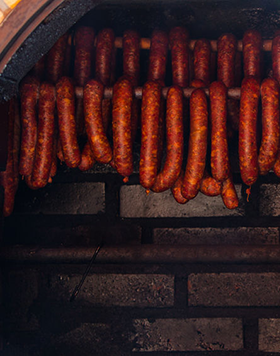
MAKING SAUSAGE
Preparing the Casings – There are four basic steps to preparing casings for stuffing.
SALTED:
- Rinse salt from casings with fresh water.
- Soften by soaking in fresh water at room temperature (approximately 70 Deg.F) for 45 minutes to one hour. When hanks are placed in water, gently hand massage them to separate the strands and prevent dry spots which may adversely affect the stuffing process.
- Take casings to stuffing table. Place in bath of fresh water. This water should be warmer to render a little of the natural fat in the casing. This will help to allow the casing to slide from the stuffing horn more readily.
- Preflush the casings by introducing water into the casings and allow to run through the casing. This will also facilitate getting the casing onto the filling horn and moving the casing smoothly during the filling process.
PRE-FLUSHED IN SLUSH:
Requires somewhat less labor and time before stuffing, but all four steps should be followed.
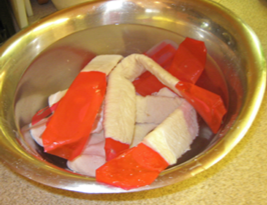
PRE-FLUSHED WET PACK:
Goods are packed in a brine with lesser amounts of salt. Requires only steps 3 and 4. Pre-tubed goods (casings on plastic tubes to speed production) usually come this way. Tubed goods may require a charge of water after they are on the stuffing horn; this is done using a horn made specifically for that purpose.
PRE-FLUSHED IN SOLUTION:
Requires no soaking time. Only steps 3 and 4 need to be performed. Casings packed this way are more prone to damage in shipping and/or from temperature changes. These casings should be purchased in smaller amounts – usually a 2 to 3 month supply, although they can be kept longer. Barrels should be carefully inspected, with leakers used first, employing steps 3 and 4.
Tubed casings:
Tubed casings are a labor saving device for the sausage maker allowing increased speed and efficiency in his production. Because tubed casings can be prepared with multiple strands of casing, the result is faster handling and stuffing times. Whether on soft or hard tubes, they are still treated by any of the above methods, depending on the requirements of the sausage maker and the type of sausage being made.
Soaking instructions of tubed casings can vary widely depending on the condition of the casings. Many sausage makers soak the tube casings over night since it can take a lot longer for the water to rehydrate the tubed casings compared with normal salted casing.
PREPARING TO STUFF CASINGS
In general, all casings can be handled in essentially the same manner; however, there are a few intrinsic variations. For example, Beef Casings, being more fleshy, can withstand more soaking and warmer water than Sheep Casings.
Beef Rounds:
Soak overnight in cold water. Then, thirty minutes before use, put casings in 38 Deg.C (100 Deg.F) water.
Hog Casings:
First, rinse with fresh water. Then, soak in 30-32 Deg.C (85-90 Deg.F) water for at least thirty minutes prior to use; soaking over night is also quite typical.
Sheep Casings:
First rinse with fresh water. Then, soak in 30-32 Deg.C (85-90 Deg.F) water for thirty minutes prior to use.
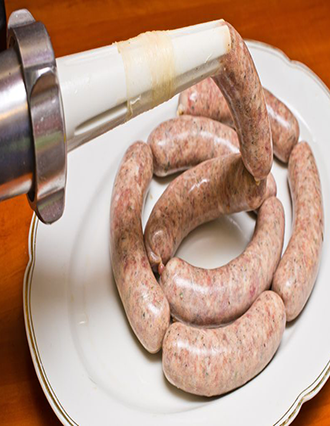
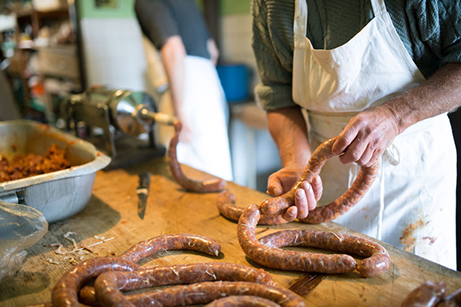
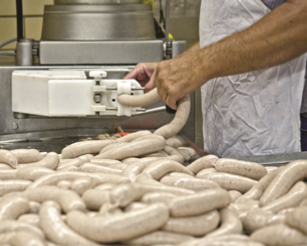
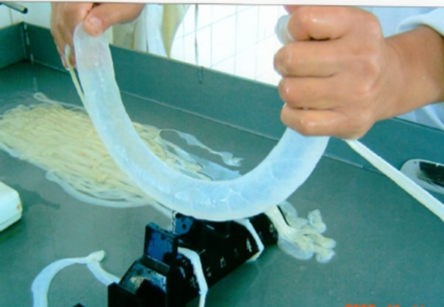
A Word on Whiskers
“Whiskers” are the capillaries that hold the intestine in the fat and provide a flow of blood to the intestine. When removing the intestine with a knife, the capillary is not completely removed, creating a hair-like appearance on the surface of the casing. After cooking, these whiskers generally disappear.
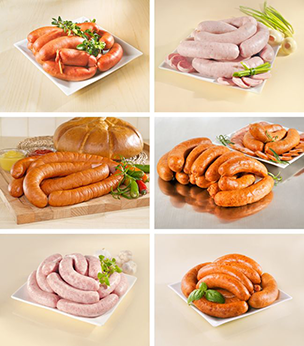
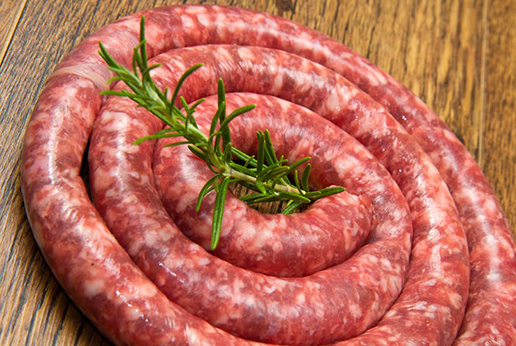
Glossary of Terms
Hog Casings – Pork intestines used to make sausage. Hog casings are primarily used for Polish Sausage, Kielbasa, Italian Sausage, Pepperoni, Country Style Sausage, Bratwurst, Mettwurst and Kiszka
Hand Pulled Hog Casing – Clearest, most uniform, whisker-free hog casing which is custom selected for uniform product quality. It has a light texture with smooth, transparent walls which allows for a tender bite. The Imported are uniform but not as tender as the North American.
Knife Cut Hog Casing – Lightly whiskered or knife cut. A strong casing for a firm stuff with less breakage and rework. The whiskers or “strings” are capillaries left that create a hair like appearance on the casing. Excellent for smoked sausage. This product is good for the price conscious sausage maker.
Colored Casing – Natural dyed casings for cooked or smoked sausage.
Hank – This unit of measure for hog and sheep casing
Salted – Method of packing casings. However, salted casings arrive dry packed to the customer. Beef casings are always shipped in salt. Sheep and hog casings can be shipped salted, slush packed, preflushed, or tubed. Salted casings travel better in the summer, but require a longer soak period than preflushed casings.
Slush Pak – Alternate method of packing casings. Hog casings are (3) hanks per net in brine solution. Beef and sheep casings are not slush packed.
Preflushed – Hog and sheep casings which are packed individually in brine solution in Vacuum Pack plastic bags.
Tubed – Alternate method of packing casings. Casings arrive to customer shirred on plastic tubes.
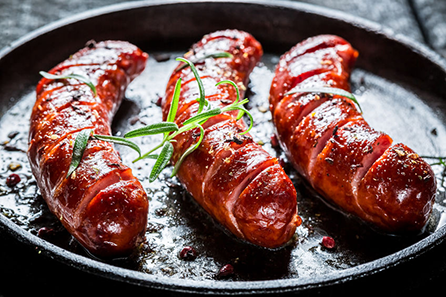
Tierce – Also known as a barrel or drum with a packing volume of 50-55 gallons.
Hog Cups or Home Packs – Hog cups packed 48 cups to a case. They are always dry packed in salt. Ideal for people who make their own sausage at home. The cups stuff out at 25 to 30 lbs. a piece.
Sheep Casings – Sheep and lamb intestines used to make sausage. Sheep casings are much narrower in diameter and thinner texture than hog casings. Sheep are primarily used for breakfast links, hot dogs, wieners, snack sticks and smokies. Hand selected Sheep casings in two categories: “A” for fine emulsion and “B” for a coarse ground product.
Beef Rounds – these casings derive their name from their characteristic “ring” or “round” shape. Beef Rounds are used for Ring Bologna, Ring Liver Sausage, Mettwurst, Polish Sausage, Blood Sausage and Holsteiner. Stuffing capacities indicated are approximate “Green Weights.” Beef Rounds are measured into sets or bundles and put up salted.
Beef Middles – can be used for Leona Style Sausage, all other types of Bologna, Dry and Semi-dry Cervelats, Dry and Cooked Salami,Kishka and Veal Sausage. Beef Middles are measured in sets or bundles. Beef Middles can be sewn so that they have a uniform diameter and a uniform length, with or without a hanger (stitching loop) and used for Super Sot, Bologna and Salami. (Also known as Beef straights).
Beef Bung Caps – Beef Bung Caps are popular for Capocolla, Veal Sausage, Cooked Salami, Lebanon and Large Bologna.
Fibrous Casings – A second class of manufactured casing known as fibrous or regenerated cellulose paper. They are manufactured using the viscose process: Wood cellulose is solubilized, treated, and viscose is formed. The viscose is then impregnated into a special hemp paper as it is being formed into a tube. 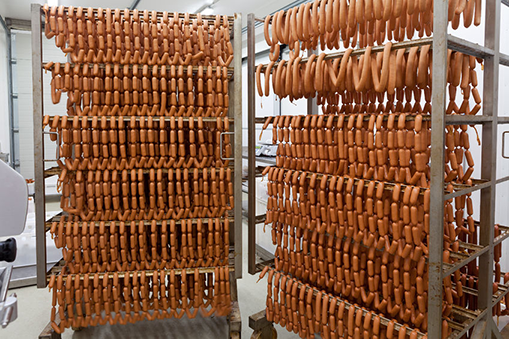
This coated tube moves into a bath which regenerates the original cellulose. Fibrous casings are used during deer season for venison, salami sticks, etc. Usual measurements are 2 1/2 x 20, string tied on one end. They can be plain or printed in a multitude of colors. Also available are shirred casings. Fibrous casings are tough enough to handle high stuffing pressure.
Collagen- Artificial edible and non-edible casings which are used for fresh and processed meat. The collagen can either be clear or mahogany colored. Collagen casings are derived by separating the corium layer and de-haired beef hides
Cellulose – skinless product offers formality. Cellulose casings produce edible skin surfaces that protect and textures frankfurters. The cellulose tube is stripped away, leaving a skinless product with a glazed surface. Cellulose comes from trees for use in most commercial applications, but cotton liners are another source. Cellulose packing material is biodegradable.
